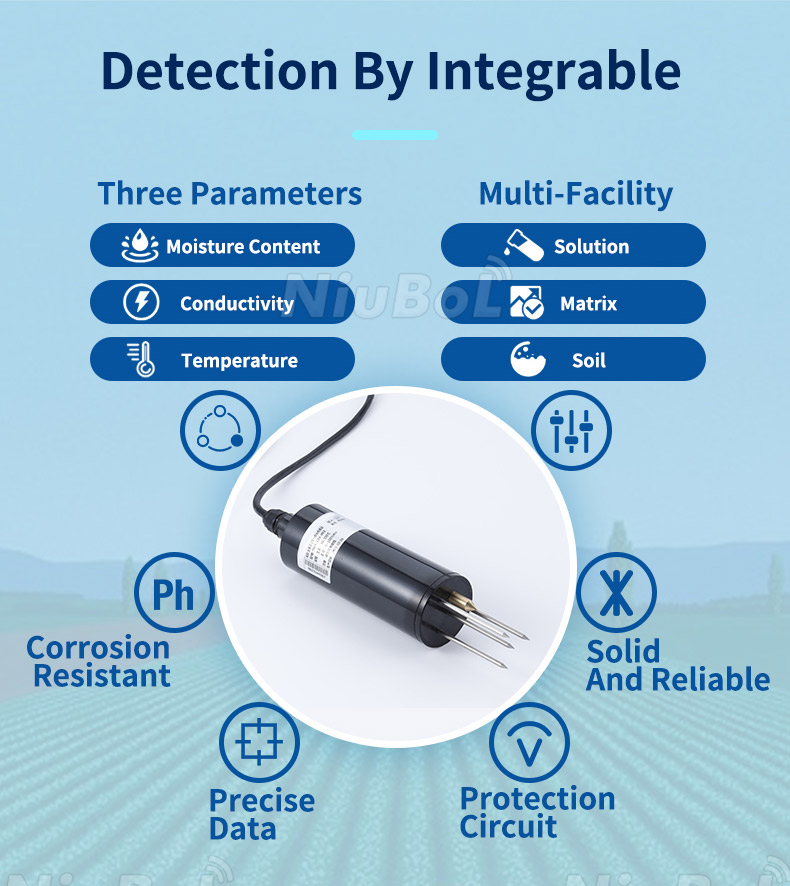

— Blogs —
—Products—
 Consumer hotline +8618073152920
Consumer hotline +8618073152920 WhatsApp:+8615367865107
Address:Room 102, District D, Houhu Industrial Park, Yuelu District, Changsha City, Hunan Province, China
Product knowledge
Time:2024-06-29 22:03:15 Popularity:2317
Soil moisture sensors are used to measure the moisture content in specific locations where they are placed in the soil. The effective coverage area of a soil moisture sensor depends on several factors:
1. Sensor Depth: The depth at which the sensor is installed determines the volume of soil it can monitor. Sensors placed deeper cover larger volumes of soil.
2. Sensor Radius: The sensitivity and radius of the sensor determine how much surrounding soil moisture it can accurately measure. Most sensors have a specified radius within which they can precisely measure soil moisture.
3. Soil Type: Different soil types have varying water holding capacities and conductivity levels, which can affect how much water the sensor can detect.
4. Horizontal Spread: Some sensors are designed to measure soil moisture over a broader area, while others focus on specific points or smaller regions.
5. Stratification: In layered soil profiles, sensors may only measure moisture content in their specific layer, although some sensors can penetrate multiple layers to some extent.
In practical applications, individual soil moisture sensors are typically used to monitor small areas, such as the root zone of a single plant or a small plot of ground. For larger areas, multiple sensors are often deployed in a grid pattern to provide a comprehensive view of soil moisture across the landscape.
For instance, common soil temperature and humidity sensors often consist of three probes, each 6-7 cm in length. The effective range of these probes typically covers an average temperature and humidity within a cylindrical shape centered on the middle probe, with a diameter of 7 cm and a height of 6-7 cm (length of the probes).

It's important to note that this is a specific example and not representative of all soil moisture sensors' measurement ranges. Different models and designs of soil moisture sensors may have different measurement areas. When selecting a soil moisture sensor, it's essential to consider whether its measurement range meets your specific needs and is compatible with the type of crop and soil conditions.
Additionally, the measurement range of soil moisture sensors is not fixed and may be influenced by factors such as soil properties, environmental conditions, and the sensor's own performance. Therefore, regular calibration and maintenance should be conducted when using soil moisture sensors to ensure the accuracy and reliability of their measurements.
Maintenance of soil moisture sensors typically includes:
1. Regular cleaning to remove dust, dirt, or other debris.
2. Checking connections and installations periodically to ensure they are intact and properly positioned.
3. Avoiding exposure to extreme conditions such as temperature or humidity extremes.
4. Replacing sensors periodically according to manufacturer recommendations or if performance issues arise.
5. Backing up data collected by sensors regularly to prevent data loss and ensure data is stored securely for future analysis and use.
In conclusion, calibration and maintenance of soil moisture sensors are crucial steps to ensure their accuracy and reliability. By regularly calibrating and maintaining them, sensors can provide consistent and accurate soil moisture data, supporting agricultural production and scientific research effectively.
1.NBL-S-THR Soil Temperature Moisture Sensor datasheet
NBL-S-THR-Soil-temperature-and-moisture-sensors-Instruction-Manual-V4.0.pdf
2. NBL-S-TMC Soil Temperature Moisture EC Sensor datasheet
NBL-S-TMC-Soil-temperature-and-moisture-conductivity-sensor.pdf
3. NBL-S-TM Soil Temperature Moisture Sensor datasheet
NBL-S-TM-Soil-temperature-and-moisture-sensor-Instruction-Manual-4.0.pdf
4. NBL-S-TMCS Soil Temperature, Moisture, Conductivity and Salinity Integrated Sensor
NBL-S-TMCS-Soil-Temperature-Humidity-Conductivity-and-Salinity-Sensor.pdf
5. NBL-S-TMCS-7 Soil Temperature, Moisture, NPK, Conductivity and pH Integrated Sensor
7-in-1-Soil-Composite-Sensor-Manual.pdf
4. NBL-S-TMCS-8 Soil Temperature, Moisture, NPK, pH, Conductivity and Salinity Integrated Sensor
Related recommendations
Sensors & Weather Stations Catalog
Agriculture Sensors and Weather Stations Catalog-NiuBoL.pdf
Weather Stations Catalog-NiuBoL.pdf
Related products
 Combined air temperature and relative humidity sensor
Combined air temperature and relative humidity sensor Soil Moisture Temperature sensor for irrigation
Soil Moisture Temperature sensor for irrigation Soil pH sensor RS485 soil Testing instrument soil ph meter for agriculture
Soil pH sensor RS485 soil Testing instrument soil ph meter for agriculture Wind Speed sensor Output Modbus/RS485/Analog/0-5V/4-20mA
Wind Speed sensor Output Modbus/RS485/Analog/0-5V/4-20mA Tipping bucket rain gauge for weather monitoring auto rainfall sensor RS485/Outdoor/stainless steel
Tipping bucket rain gauge for weather monitoring auto rainfall sensor RS485/Outdoor/stainless steel Pyranometer Solar Radiation Sensor 4-20mA/RS485
Pyranometer Solar Radiation Sensor 4-20mA/RS485
Screenshot, WhatsApp to identify the QR code
WhatsApp number:+8615367865107
(Click on WhatsApp to copy and add friends)